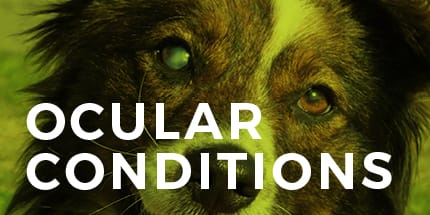Healthy eyes help horses live a safe, productive life
A Q&A with Brianne Radulovich, DVM, Comparative Ophthalmology Resident
Eyecare for horses? Just like us, horses are prone to ocular issues. With their horizontally, elongated pupils, a horse’s eye is eight times larger than the human eye. They use it for light capture and motion detection. With a total vision [READ MORE]
Common dog and cat eye injuries
Causes, treatment and how to avoid them
Dogs will be dogs. No matter how attentive the pet’s parent is, there are times when animals will dig in the dirt, paw at their eyes or get in a tussle with another pet. Seemingly minor ocular irritations can turn [READ MORE]
Cataracts and Other Common Eye Issues in Senior Dogs
Just like human eyes, dogs’ eyes change as they age. These changes can be concerning for pet parents when they see a difference in the appearance of their dogs’ eyes. Or, if they notice other signs, such as squinting, scratching or pawing at the eye and bumping into objects at [READ MORE]
Make Preventive Care a Priority for your Pet this Year
New Year’s resolutions are now in play. It seems everyone we know is contemplating ways to eat healthier, move more and reduce stress. Scheduling a checkup with your physician is an excellent step to address such questions and keep potential health concerns at bay. And guess what? It is also [READ MORE]
We treat cats too! Common feline ocular conditions
By Heather Brookshire, DVM, DAVCO
We see a lot of dogs at our practice, but we give equal time to our feline patients too! Cats can develop a number of ocular conditions, and we thought it would be helpful to outline some of the common eye issues in cats and how we treat them.
To [READ MORE]
Keeping an Eye on Hypertension in your Pet
By Amanda Romaneck, DVM, Ophthalmology Resident
You or someone you know may have hypertension, also known as high blood pressure. But did you know that dogs and cats can be diagnosed with this condition too?
Systemic hypertension happens when there is a persistent elevation in one or all blood pressure parameters [READ MORE]
Diabetes and the Eye
Diabetes mellitus affects dogs and cats in much the same way it affects humans. Most people, however, are unaware of the numerous ocular changes that can develop secondary to the condition. This can include KCS (dry eye), corneal changes, rapid cataract formation, uveitis and hypertension/retinal changes. Read on to learn more [READ MORE]
Feline Herpesvirus and Treatment
If you have noticed nasal congestion, discharge and signs of a ‘pink eye’ in your cat, they may have Feline Herpesvirus. This viral upper respiratory infection is common and highly contagious. Read on to learn more about this condition, causes, and how it is treated.
Common and highly contagious, Feline herpesvirus (FHV-1) [READ MORE]
Caring for Your Pets When the Weather is Frightful
Tucked as we are in this temperate corner of Southeastern Virginia, we don’t face freezing weather too often. On the occasions we do get snow and ice, we need to make sure our pets can go outside to stretch their legs, take a walk and do their business without harm. [READ MORE]
Uveitis Symptoms Reveal Lyme Disease in Most Unusual Case
Meet Prancer, a sweet lady we met last fall. After presenting to a local veterinary hospital with signs of decreased energy and appetite and squinting in her eyes, fluids were administered under the skin for concern of a toxin ingestion and stomach pain.
Over a few days, things changed quickly. Prancer [READ MORE]
Uveitis Causes and Treatment
Uveitis is an ocular condition that occurs when the uveal tract within the eye becomes inflamed, which can lead to alterations in vision, intraocular pressure and comfort. Read on for common clinical signs, how we test for the condition, causes, and treatment options.
Uveitis is inflammation of the uveal [READ MORE]
Pannus Cases Increase with Summer Heat
With the arrival of the summer sun and increased UV exposure, we usually see an uptick in cases of pannus at our practice. Also known as chronic superficial keratitis, pannus is a progressive inflammatory autoimmune disease of the cornea. It is seen most commonly in German shepherds and related [READ MORE]
Traveling to See Us For Cataract Surgery? Here’s What You Need to Know.
We often see clients from out of the area, who travel to see us for their pet’s cataract surgery. We thought it would be helpful to explain what happens before, during and after surgery so you can plan accordingly.
Cataract surgery is very similar to cataract surgery in people. A small [READ MORE]
Pet Patient Focus on Brady Colby—Seeing 20/20 in 2020
In the summer and fall of 2019, Donna Colby noticed changes in her dog Brady’s eyes. They had a cloudy appearance, along with redness, irritation (rubbing) and a clear discharge. Donna told us her pet was also demonstrating concerning behaviors including clumsiness that led to several falls, failure to clear [READ MORE]
Focus on Corneal Endothelial Degeneration
Corneal endothelial degeneration (CED) is an age-related process by which the single layer of cells on the inside of the cornea (endothelial cells) prematurely decline in number and function. These cells contain tiny “pumps” that normally regulate the amount of fluid within the cornea throughout life and help to ensure [READ MORE]
Be Kind, I’m Blind
You’ve just learned that your dog is slowly losing his or her vision, or perhaps it happened quickly and your pet is now blind. This will be a time of transition for you and your pet, but with some adjustments to your home and routine, a wonderful new life awaits [READ MORE]
No More Tears!
Have you noticed tearing under your dog’s eyes, or do you see staining under or around her eyes as a result? Tearing is caused by an overflow of tears onto the face that is often due to the way the eyelids are shaped. While each case should be evaluated to [READ MORE]
Powerhouse of a Pet! Meet the English Bulldog
If you own or know an English bulldog, you understand what sweet and dependable pets they can be. Originally bred for working with bulls, this canine can be dogged in their pursuits, but are also known for their congenial temper and laid-back ways. That sweet flat face with all those [READ MORE]




























